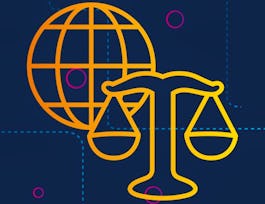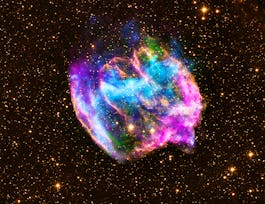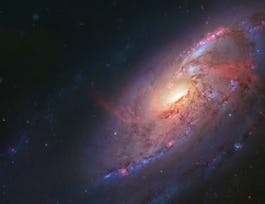In this MOOC, you will have the opportunity to practice several methods of detection and characterisation of exoplanets.



(29 avis)
Expérience recommandée
Ce que vous apprendrez
You will explore the different ways of detecting and characterising exoplanets.
You will learn about the physics of atmospheres, which is the key to discovering possible extraterrestrial life.
You will get an overview of future space projects and missions in the field of exoplanets.
Compétences que vous acquerrez
- Catégorie : Light Curve inspection and analysis
- Catégorie : Exoplanets physics
- Catégorie : Exoplanets detection
- Catégorie : Spectroscopy
- Catégorie : Exoplanets characterisation
Détails à connaître

Ajouter à votre profil LinkedIn
7 devoirs
Découvrez comment les employés des entreprises prestigieuses maîtrisent des compétences recherchées


Obtenez un certificat professionnel
Ajoutez cette qualification à votre profil LinkedIn ou à votre CV
Partagez-le sur les réseaux sociaux et dans votre évaluation de performance

Il y a 7 modules dans ce cours
If you want to talk about exoplanets, there is no miracle, you have to go through the fundamentals of astrophysics. This is why we propose that you first approach astrophysics from a more historical and fundamental point of view. How did the representation of the universe evolve? How was the modern vision of "celestial mechanics" constructed? You will have the pleasure of discovering the answers to some of these questions. However, in order to go further in this course, we will also see Kepler's three laws as well as some basic notions about protoplanetary disks, planets or star formation. In this first module, we propose to lay the foundations necessary to deal with the concept that interests us all: exoplanets.
Inclus
10 vidéos2 lectures1 devoir
In this second module we will focus on the detection of exoplanets. Together we will discover three methods for detecting extrasolar planets. (1) Radial velocities, which allowed the first detections of hot Jupiters. (2) Astrometry, a method that the Gaia satellite has greatly contributed to boosting. (3) Direct imaging, the only way to really see planetary companions. Don't be scared off by the mathematical approach used to describe these methods. A general understanding is sufficient to follow the next few weeks of the course.
Inclus
7 vidéos1 lecture1 devoir
For this third module, we remain in planet detection. However, this time we will explore the specific case of a planet being seen nearly edge-on and transiting its star. The observation of exoplanet eclipses (transits and occultations) provides us with a wealth of parameters and is currently the most powerful technique to study the structure and other intrinsic properties of planets. In this module, you will therefore have the opportunity to discover mainly how to apply the transit method, but also, at the end of the module, the main outcomes that have been obtained through the use of the transit method.
Inclus
12 vidéos2 lectures1 devoir
Now let's dive into statistics! In this module, we will be interested in the statistical properties of planetary systems. We have chosen to use a chronological approach to do so. First of all, you will discover the first results of the radial velocity programs which unveiled the great diversity of planetary systems. We will then compare these results with those obtained more recently by the transit surveys and the most recent radial velocity surveys. The statistical results of these research programs have brought to light a multiplicity of discoveries around exoplanets. You will have the pleasure of discovering them throughout this module.
Inclus
8 vidéos1 lecture1 devoir
For this fifth module, let's continue our exploration of statistical methods! We will continue to discover the properties of the exoplanetary systems that have been detected so far. You will have the opportunity to understand the link between the properties of the planets and the mass of the central star. We will also see in more detail the dynamics of multiplanetary systems, how planet-planet interactions are translated and, in particular, what are the parameters that influence the stability of systems.
Inclus
8 vidéos1 lecture1 devoir
Let us leave now the statistical analyses to go and look at the properties of the surfaces and atmospheres of exoplanets. In the previous modules, we have seen that radial velocity measurements combined with transits observations allow us to have access to the average density of exoplanets. We could thus put some constraints on the internal structure of the objects. Although only a few very specific systems (young and massive planets with large separation) have been imaged so far, spectroscopic measurements and subtle strategies of observation of transiting and non-transiting systems allow us to know the characteristics of planetary surfaces and atmospheres. This is all we will see together for this penultimate module.
Inclus
12 vidéos1 lecture1 devoir
For this last part of the course, let's continue and complete our exploration of the atmospheres of exoplanets. This module is in fact an update of the course. It integrates the new insights obtained on exoplanet atmospheres since 2014 (date of the first edition of this MOOC). Actually, the content of these last videos is very close to what you would get if you were attending a review on the subject at a real scientific conference. We hope you will enjoy this journey through the different layers of the atmosphere of exoplanets!
Inclus
8 vidéos1 lecture1 devoir
Instructeurs



Offert par
Recommandé si vous êtes intéressé(e) par Physics and Astronomy

Imperial College London

Rutgers the State University of New Jersey

University of Rochester

Columbia University
Pour quelles raisons les étudiants sur Coursera nous choisissent-ils pour leur carrière ?




Avis des étudiants
Affichage de 3 sur 29
29 avis
- 5 stars
86,20 %
- 4 stars
10,34 %
- 3 stars
0 %
- 2 stars
3,44 %
- 1 star
0 %

Ouvrez de nouvelles portes avec Coursera Plus
Accès illimité à plus de 7 000 cours de renommée internationale, à des projets pratiques et à des programmes de certificats reconnus sur le marché du travail, tous inclus dans votre abonnement
Faites progresser votre carrière avec un diplôme en ligne
Obtenez un diplôme auprès d’universités de renommée mondiale - 100 % en ligne
Rejoignez plus de 3 400 entreprises mondiales qui ont choisi Coursera pour les affaires
Améliorez les compétences de vos employés pour exceller dans l’économie numérique
Foire Aux Questions
dwkmdwk
Access to lectures and assignments depends on your type of enrollment. If you take a course in audit mode, you will be able to see most course materials for free. To access graded assignments and to earn a Certificate, you will need to purchase the Certificate experience, during or after your audit. If you don't see the audit option:
The course may not offer an audit option. You can try a Free Trial instead, or apply for Financial Aid.
The course may offer 'Full Course, No Certificate' instead. This option lets you see all course materials, submit required assessments, and get a final grade. This also means that you will not be able to purchase a Certificate experience.
When you purchase a Certificate you get access to all course materials, including graded assignments. Upon completing the course, your electronic Certificate will be added to your Accomplishments page - from there, you can print your Certificate or add it to your LinkedIn profile. If you only want to read and view the course content, you can audit the course for free.








